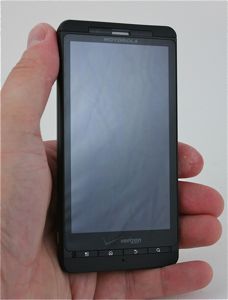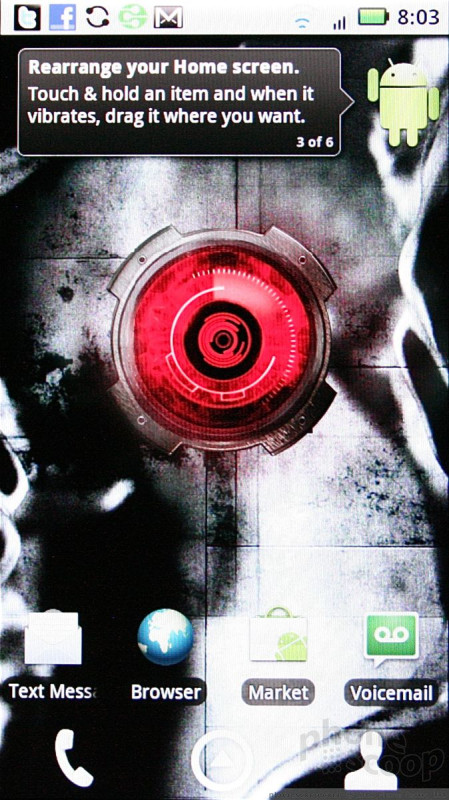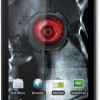Review: Motorola's Droid X
Jun 25, 2010, 11:04 AM by Eric M. Zeman
Motorola swings for the fences and hits a home run with the Droid X. Verizon Wireless' new flagship device delivers on almost every feature, making it one of Motorola's best-ever phones.
Form
Is It Your Type?

The Motorola Droid is the new King of the Hill over at Verizon Wireless. You want to do battle with other Android handsets? The Droid X is the phone to pick. It boasts top specs and top performance in a hardware design that is probably the best to come out of Motorola's engineering labs. The Droid X is big, beautiful, and bound to steal some hearts.
Body
As with the HTC HD2 and EVO 4G, the Droid X has a 4.3-inch display. With a display that large, the phone itself has to be pretty big, and indeed the Droid X is huge. It is light weight and thin, but the length and width are a force to be reckoned with. The materials of the Droid X are top notch. The plastic, metal and glass all feel high quality. The build of the Droid X is as good as you can ask for in a handset. Most of the platter-sized Droid X is thin, but there's a significant bulge where the camera module is. If you stick the Droid X into a tight pair of paints with the bulge first, you're *really* going to know the Droid X is there.
The front of the Droid X is dominated by the large LCD. There are four buttons — the standard Android Menu, Home, Back, and Search keys — below the screen. Unlike the original Droid and the Droid Incredible, the Droid X goes for physical buttons. I am fine with this. It is easy to find them without looking. Travel and feedback were OK, though not quite as good as I'd like.
There are no buttons on the left side of the Droid X. The microUSB and HDMI ports are paired together close to the bottom edge of the phone. The volume toggle is tucked on the right side of the phone, near the very top. It is a little bit on the small side, but travel and feedback were good. The dedicated camera key is also on the right side of the phone, near the bottom edge. It is a two-stage key for focusing before taking the picture. It is big enough to be easily found, and the two-stage action was spot on.
The power/lock key is placed on the top of the Droid X. Motorola did a good job with this button. It has just the right amount of definition so it is easily found, and the travel and feedback were excellent. A 3.5mm headset jack is next to the power button.
My biggest — and probably only — real gripe with the Droid X hardware is that the battery cover and the battery need to be removed to get at the microSD card. I switch my media around often, so this is a personal niggle. Most people probably won't bother with the microSD card more than once or twice.
In all, the hardware easily bests the original Droid in terms of overall quality, feel and sex appeal.
The Three S's
Screen
The Droid X uses a 4.3-inch LCD with 854 x 480 pixels. It looks gorgeous. It's no Super AMOLED, but it performs well enough. Icons, graphics, and text look stunning, and the display is plenty bright for any sort of indoor viewing. Outside, things become more problematic. Direct sunlight almost completely obscures the display. Partly cloudy skies are less troublesome, but still make reading the display outside difficult.
Signal
I've only had the Droid a short time, and have yet to run it through my normal battery of signal tests. That said, I saw pretty good signal performance. Both in Manhattan and around northern New Jersey the Droid X typically held onto three or four bars. I never saw it drop to one or fewer bars, and it also never dropped to Verizon's 1X network. It stayed connected to Verizon's EVDO 3G network the entire time I used it. So far, it hasn't dropped any calls, and data speeds appear to be consistent.
Sound
Call quality was solid during the few calls that I made. It wasn't as good as the Nokia E73 Mode, which Phone Scoop recently tested, but it gave me no trouble. I didn't hear any pops or hissing, and volume was consistent during calls, though it sounded just slightly muffled, as when talking through a screen to a priest during confession. Earpiece volume was very good. It was loud enough to hear callers in a very noisy and crowded mall. Speakerphone quality and volume were also good. I'd say using the Droid X as a speakerphone in a small office would be just fine. Ringers and alert tones were loud enough, but just barely. Set to maximum, I wouldn't be surprised if you missed a call or two in noisy places because you couldn't hear the ringer.
Battery
I don't have quite enough data to share at this point. What I can say is that I received the phone with an 80% charge at 2PM. After heavy use, the Droid X still had 50% at 11PM. That's not bad at all, though I hadn't synced email. Today, I left the house at 5AM with a full charge. After 9 hours of email, Twitter, etc., it still has 70% charge.
Basics
Menus
The Droid X runs a slightly modified version of Android 2.1. Motorola has promised that Android 2.2 and Flash Player Mobile 10.1 will be added by the end of the summer via an over-the-air software update.
The Droid X has seven home screens, each of which has been crammed with content by Motorola and Verizon Wireless. All of the content can be customized at will and moved, deleted, rearranged, etc. One thing I don't like are the little indicators at the bottom of the screen that tell you which screen you're on. On most other Android handsets, these indicators are small and unobtrusive. On the Droid X, they are huge, animated, and get in the way of accessing the app drawer.
Perhaps the most novel new thing the Droid X offers is resizable widgets. Don't like how big that weather widget is? Press and hold briefly. A crop tool will appear on the widget, and you can use the crop tool to reshape the widget, make it smaller or bigger. Fun.
Motorola says that it has customized the Droid X with some elements from Motoblur. Before you freak out and say, "Aw snap!", calm down. The elements are all buried under the hood. You won't even notice them. Perhaps the only real evidence the elements are there at all are the customized social networking widgets that the Droid X has preinstalled. If you want to skip those widgets, go right ahead and use Twitter and/or Facebook widgets directly.
The rest of the menu system appears to be unmolested Android 2.1. All the same options, menus, and themes are present.
One thing to note, the Droid X stuttered from time to time, and froze every now and then. Verizon Wireless said that the review units we have in hand are not running final software, so that is likely the cause of the freeze-ups.
Calls/Contacts
Calls
The Droid X's phone application appears to be exactly the same app that Motorola used on the original Droid. From the home screen, press the phone icon and the dialer pops open. The dialer is the stock Android dialer. There is a large number pad in the middle of the screen, and there are four tabs along the top to access the call log, contacts and favorites. The Droid X offers haptic feedback when you dial numbers, which is a nice touch (pun intended). Users can choose to disable that if they wish.
From the call log, press any call record quickly and it will open up the list of recent calls to and from that number, along with links to send that person a text message or view the full contact details. If you press and hold a call record, a menu screen pops up with a list of options, which include calling the number, deleting the call log and so on. To the far right of the call log is a green phone symbol. Press that if you want to start a phone call right away.
Skype Mobile is also preloaded. With Skype, you can make free calls to other Skype numbers (even ones over in Europe), conduct IM chats, and otherwise keep in touch with contacts. The Skype Mobile app for Android runs via Verizon's voice network (not VoIP via Wi-Fi), which means call quality is the same as making a normal voice call. Through Skype, users can also call regular landlines or cellular numbers, but those types of calls cost money.
Contacts
The Droid X will import all your Google and Exchange contacts if you have them. Adding Facebook friends is optional. If you choose to do that, the contacts application is smart enough to add the Facebook profile photos to your existing contacts and merge them into one contact. So, if you're friends with Jimmy Jones on Facebook and he's also a Gmail contact, you'll see only one entry for Jimmy, not two.
In the contacts app, press the profile picture (or the little Android if there's no profile picture) and a little messaging menu pops up for that contact. If you have a phone number, it will show you the phone symbol to make a quick call, and you'll also have shortcuts to send your contact an SMS, write an email or go to the Facebook profile. If you know what you want to do when pressing a given contact, this makes the task just that much faster.
Alternately, if you press the area next to the profile picture/Android, it will simply open the contact's page. Use the menu key to make changes or perform other actions.
You can also choose to sort contacts via status updates and/or your most recent calling/texting history. (Hint, this is where Motoblur comes to play.) In the main contact app, swipe to the left to see all the most recent messages you've sent/received and who you've sent them to. Swipe to the right to see your contacts' most recent Facebook (and Twitter if you want) status updates.
Messaging
The Droid X comes with support for multiple Exchange accounts, Gmail, POP3 and IMAP4 email from just about every vendor there is. For the most part, all it takes is a username and a password to sign up. Both Exchange and Gmail will also marry your contacts and calendar to the Droid X, which is convenient.
The Gmail application is the most powerful of the email clients. It is so natively entwined with the way that Gmail works online that you hardly feel like you're using it on a phone. My favorite feature? The ability to Star emails.
The Droid X has a universal inbox that collects all SMS, Twitter DMs and Facebook emails in one spot. It's a neat concept to tie together all the social networking stuff — which often arrives in the form of an SMS — with the actual SMS application. The universal inbox doesn't thread conversations from Twitter DMs together, or even Facebook emails, but it will thread SMS text conversations. Threaded messaging is the only civil way to deal with text messaging any more.
On the instant messaging side of the coin, Google Talk is built in. Nothing else is. If you need access to Yahoo, AIM, or Windows Live, you're going to have to search the Android Market for 'em.
Visual voicemail is available if you don't mind paying Verizon a $2.99 monthly fee.
Social Networking
Thanks to the way Android has been engineered, support for Facebook is part of Android's blood. Users' Facebook accounts merge seamlessly with Gmail or Exchange contacts, and the way Motoblur treats them in the contact app is simply elegant and the way things should work.
There are multiple avenues into the social networking scene with the Droid X. First, there are the stand-alone and dedicated Facebook, MySpace, and Twitter apps. Motorola has also created its own widgets for these applications. They are best used for posting status updates to multiple accounts at once. Motorola's home-baked software isn't as good as the dedicated apps at allowing users to interact with their friends. For instance, you can't respond to Twitter DMs from the home screen widget. You have to jump into the unified inbox to do that. And if you're going to go that far, you may as well open up the regular application.
Of course all these applications alert users unobtrusively via the Android notification system. As your Facebook and Twitter streams are updated, notifications appear at the top of the screen. Pull down the notification shade to see what messages have been flung your way.
The Android platform is one of the best for social networking, and the Droid X leaves nothing out.
Extras
Music
The Droid X comes with the newer Android music player. It isn't much different from the original music player that debuted on the G1 20 months ago. It offers basic library organization. If you want to add music to the microSD card, you have several options: 1. Pull out the card, stick it in your PC and drag-and-drop files directly onto the card; 2. Connect the Droid X via USB and choose "USB Mode" when the Droid X connects to the PC; 3. Use third-party software such as doubleTwist (separate download). Once your media is loaded, you're good to go.
The stock media player is bare bones, and I am growing tired of it — but it does get the job done. You can sort through your playlists, artists, albums and songs easily enough, and album art comes through properly when tagged to the music. The media player can be sent to the background while you do other things such as browser the web or check Twitter.
Music can be played back through regular stereo headphones or via stereo Bluetooth if you're into that sort of thing. Sound quality through wired headphones was excellent. Stereo Bluetooth wasn't quite as good.
Motorola CEO Sanjay Jha was asked during the Droid X press conference when a desktop media management app would become available. He said they are working on one, though he didn't say when it would be ready. Until then, you'll have to stick with third-party software.
The Droid X also has an FM radio. It worked surprisingly well, though stereo headphones are required in order for it to work.
Video
Perhaps due to the ginormous display, Verizon is pitching the Droid X as a video monster. Does it live up to that claim? Well, that depends.
There is a Blockbuster application preinstalled. You can rent movies from it for $4 for a 24-hour window. Movies cost $15 to $20 to buy.
I side-loaded three movies. Two of them played back with no problems, but one wouldn't play at all. The two that worked looked great on the Droid X's display, though a darker room is the best place to watch. Sun glare and reflections can easily mar a movie.
The Droid X also has Verizon's V CAST Video service on board. V CAST Video lets you stream video clips over Verizon's 3G network. This is not the same as MediaFLO's V CAST TV, which is live television. V CAST Video costs extra to access. Our review unit wasn't properly provisioned to test it out.
The other big feature is the MediaShare software and HDMI out port. MediaShare ties together with DLNA and can let Droid X users access or send content to/from the Droid and other DLNA-equipped devices. It works with protected content and unprotected content. The movies that I have ripped on my own at home wouldn't playback through the MediaShare software, though, rendering it useless in my tests.
Camera
Camera
The Droid has an 8 megapixel camera. Camera features include autofocus, dual-LED flash, and a mechanical shutter. Very few phones have shipped with mechanical shutters. This is important because it helps increase clarity and detail in action shots (which might otherwise be blurry).
Press and hold the dedicated camera key to launch the camera. It opens much slower than I'd like. It probably takes 2 or 3 seconds to launch. You expect faster performance than that when there's a 1GHz processor under the hood.
The camera controls and user interface have been modified a bit in a positive way. Motorola has opted to skip the awkward pull-out drawer normally found on the left side for much easier icon-based controls. The right side of the display has four large icons to quickly adjust exposure, color treatment, the flash, and switch to the video recorder. Want to make a change to any of these settings? Simply press the icon, and then swipe left or right to cycle through the options. Nice and easy.
You have to use the physical menu button to get at some of the finer controls, such as changing ISO ('sensitivity' of the camera) or the number of megapixels captured. Oddly, the default setting for the Droid X is 6 megapixels, which Motorola says is perfect for shooting 16:9 shots formatted for HDTVs. You can dial up to 8 or as low as 2 megapixels if you want.
The Droid X focuses in about one second, and then takes about another second to capture and process images. Once captured, images can be sent, shared, deleted and fired off in pretty much every way imaginable.
It is perhaps notable that the Droid X does not have a user-facing camera.
Gallery
The Droid X has a new custom-made photo gallery widget built into the home screen that I really like. Choose an album, and the gallery (which sits in a picture-frame type graphic that consumes about 50% of the display) will automatically play a slide show. The slide show shuffles across the little window pane, letting you see your images. It's neat, but viewing them in full glory in the main gallery application is still more satisfying.
The gallery automatically sorts folders and albums. Personally, there are a few too many steps to get to a view of your images, with a few too many folders to dig through. The problem is there are separate storage locations (internal and microSD card), and the Droid X is aggressive about keeping these folders separate.
Organization aside, slide shows of images look glorious on the large display. Images float past quickly, and when you can share such large pictures it makes the whole experience a lot more enjoyable.
There are also a host of editing features, but you have to dig to find them. You can apply effects, crop, rotate, color/brightness corrects all after the fact if you wish.
Photos/Video
Photos
The Droid X's 8 megapixel shooter did a great job. It had better, given the size of the lump it creates on the back of the Droid X. Color representation was spot on, white balance was accurate, and it had no trouble performing well in both darker and brighter environments. The mechanical shutter does in fact help make for sharper pictures. For the casual tourist, I'd say the Droid X comes as close as you're going to get to replacing your point-and-shoot. It won't replace a dSLR, but you can leave the little camera at home this summer. You'll be pleased enough with the results to share them via Facebook, Flickr, and Picasa. Heck you might even print a few out.
Our review unit has crashed, preventing us from sharing photos and video taken from it. We're doing our best to get it back up and running again. Hopefully we'll be able to post pictures and video soon.
Video
The Droid X can record video at 720p HD resolution at 24 frames per second (the same frame rate as movies). The results are good. The Droid X reacted well to drastic changes in lighting, it captured sharp and fine detail, and even when zoomed in it performed above par.
Browse/Customize
Browser
The Droid X has the mostly-excellent Android browser. I didn't notice too many changes to the base software save for one neat trick.
When rotated on its side, the Droid X offers the neatest version of visual bookmarks / browsing history that I've seen. It works similar to the way CoverFlow does for the Apple iPhone. Your browsing history and bookmarks are laid out in a 3D set of pages that you flip through. Each page has a render of the web site, so you can see what it looks like. It's spiffy, and fun to use.
When held in an upright, portrait position, the bookmark feature acts the same as on other Android handsets.
Otherwise, there is very little to separate the Droid X's browsing performance when compared to the large crop of Android handsets out there.
...unless you're talking about speed.
The Droid X is one of the fastest browsing devices I've ever used. Web sites rendered almost instantly when browsing via Wi-Fi. Pages loaded in a blink. Browsing speeds via Verizon's 3G network were only slightly slower. The Droid X's browser burns, baby. It burns!
Customize
This is an Android device. All seven home screens can be adjusted and populated with whatever apps, widgets, or shortcuts that you want. The additional feature of resizable widgets makes for a whole new realm of customization.
At this point, the one piece of Android that can't be altered is the way menu themes are treated. The Droid X, as with pretty much every other Android handset out there, uses the same white-on-black menu. It's getting tiresome. I wish you could change the colors in there.
Beyond that, the sky is practically the limit.
Extras
Bluetooth
The Droid X supports both mono and stereo Bluetooth headsets. I was able to pair it successfully with a number of different devices, including two PCs and various headsets. Call quality was excellent through a stereo headset. What's really great is that the Droid X supports voice commands via Bluetooth. That's an added bonus. Music sounded good through stereo Bluetooth headphones, though it wasn't quite up to par with the mono headset.
Clock
A quick press of the lock key lights up the screen and shows the time nice and large. The time is nearly always visible in the top info bar. There are so many clocks and clock skins you can download from the Android Market, you can really configure the clock in pretty much any way you like.
GPS
The only navigation service on board the Droid X is Google Maps. VZ Navigator is absent, and that's fine with me. I haven't had time to do a test trip with Google Maps on the Droid X, but Google Maps is pretty proven software on Android handsets at this point. In the few GPS tests I conducted, the Droid X pinned my location to within about 10 feet in less than 15 seconds. That's pretty good GPS accuracy.
Video Tour
Here is a video tour of the Droid X.
Wrap Up
The Droid X is an all-around great phone. There's very little to complain about. Perhaps the biggest reason to test it out before committing to a two-year contract is the big-ness, er, size of the Droid X. It is as big as cell phones get, and some may find the size unappealing.
The Droid X nails the basics. Call quality is excellent, contacts management is rich and well-developed; and every form of messaging known to man is available from the Droid X. So far, battery life has been above average for an Android handset.
The Droid X performs well with music and video content, though Apple's iPhone still wins the media race. The various video options on the Droid X make it a better video device than most other Android handsets to date, though you may find yourself paying for that content (Blockbuster, V CAST Video).
The camera does an outstanding job at capturing images accurately and with detail. The revised camera software is more finger friendly, and this makes interacting with the camera a breeze. The only disappointment is that the Droid X's camera still isn't as fast as it should be.
The Droid X comes with the solid Android browser, access to the Android Market, and has apps such as Skype Mobile.
Motorola has crafted a fine phone in the Droid X, the best in Verizon Wireless' current line-up.
Comments
Sound Quality (muffled) and number of screens (configurable)
👀 The reason I ask, is that the Motorola support forums, and my practical experience with the Droid (1 / Classic) is a muffled sound (microphone) heard by the other party. It seems to be user specific in that all of the people (20%-40% of users) who have reported muffled sound, when trying a different (or multiple) Motorola Droids, still had the muffled sound issue. The majority of users (60-80%)are not reporting muffled sound issues. 😲 Motorola has not acknowledged this as an issue; but believes if there is a "muffled perception" it is most likely location specific, ho...
(continues)
External Antenna on Droid X?
Does the Droid X have this connector? Do you know what size/type connector it is? Do you know where I can buy an "antenna adapter cable" for this connector (if there is one)?
Thanks,
Jack
Hdmi output on the phone
But the droid is GETTING that browser soon. Androidcentral.com is going to run some benchmarks soon, but they said that on...
(continues)
What's the 3D performance like?
























































 First Look: Motorola Droid X
First Look: Motorola Droid X
 Verizon Wireless and Motorola Launch Droid X
Verizon Wireless and Motorola Launch Droid X
 Motorola Droid X
Motorola Droid X



